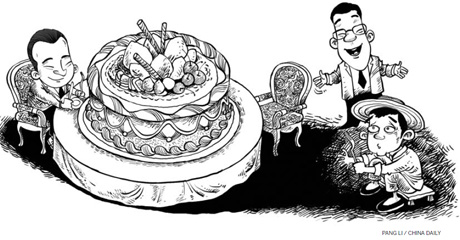Op-Ed Contributors
Is the wealth gap widening?
By He Bolin (China Daily)
Updated: 2011-04-14 08:02
 |
Large Medium Small |
Some experts argue that the Lewisian Turning Point can't be applied to China where farmers working in cities are still treated as rural residents. But Cai says that can be attributed to China's special urban-rural structure, and the Lewis Turning Point, as a general economic concept, is very much applicable to the country.
Given the trend of rising wages, he says, the current labor shortage in China is relative rather than absolute. And wages have risen because the demand for labor is growing faster than its supply.
Besides, the average age of migrant workers has been increasing, which means their number is also increasing. Many of the first-generation migrant workers returned to the countryside once they reached their 30s. But with far more jobs available now, a larger number of migrant workers are staying in cities much longer.
The government's drive to develop Central and West China has created many jobs, too, and higher wage offers will ensure that more surplus labor from the countryside is drawn to those regions.
Cai objects to everyone complaining about the wealth gap when the task now is to find ways to narrow it. "The gap won't narrow on its own." One way of reducing it is to reform the individual income tax system, he says.
Personal income tax may have made up only 6.6 percent of the government's total tax revenue last year, but it is a heavy burden for low- and medium-income groups. It's time the government increased the income tax threshold for the low- and medium-income groups. To offset the loss in revenue, it can levy higher taxes on the rich and superrich.
Cai also suggests setting up a collective wage consultation system in which labor authorities, trade unions and the business enterprises would represent their sectors. No, it would not be a platform for bargaining. Rather it would be a place to hold serious and scientific discussions on data and to analyze industries' prospects, which will help the representatives to suggest more ways to reduce the income gap.
On the social security front, China has established two systems: a basic old-age insurance system for urban residents and a new rural social endowment insurance system. There are plans to expand the rural social endowment system to cover 40 percent of the people in the countryside.
In some countries, social security is part of social welfare regardless of whether a person's social contribution entitles him/her for such treatment. China's rural social endowment insurance system follows the same principle. Given the prevailing conditions in the country, its standard may be relatively low. But a lower level will facilitate wider coverage.
And of course a certain percentage of State-owned enterprises' profit should be used to improve social security.
With so much happening and indications of more to happen how can we say that the wealth gap is widening further in the country? Cai says.

(China Daily 04/14/2011 page9)
| 分享按鈕 |